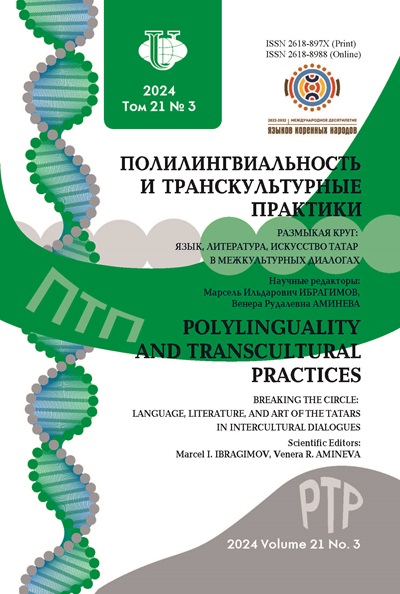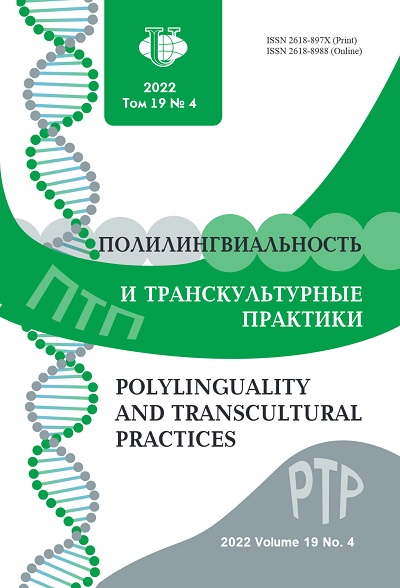Formation of the Linguistic Picture of the World of Bilinguals
- Authors: Afanasieva N.D.1, Zakharchenko S.S.1, Mogileva I.B.1
-
Affiliations:
- Moscow State Institute of International Relations (University) of the Ministry of Foreign Affairs of the Russian Federation
- Issue: Vol 19, No 4 (2022)
- Pages: 587-595
- Section: Language in System
- URL: https://journals.rudn.ru/polylinguality/article/view/32859
- DOI: https://doi.org/10.22363/2618-897X-2022-19-4-587-595
Cite item
Full Text
Abstract
The authors of the article analyze the specifics of the formation of the linguistic picture of bilinguals, in whose minds two cultural codes are combined. The authors suggest that the linguistic picture of the world of bilinguals differs from the picture of a native speaker. When forming a bilingual linguistic personality, two cultures merge in his mind; many historical, social facts, influenced by individual and personal views, judgments, assessments, get a brighter color, are described differently, which makes it possible to understand the worldview of another person. Natural bilinguals, unlike artificial ones, have a combination of two pictures of the world, two cultural codes. However, both pictures in the mind of a bilingual, who is not divorced from one of the language environments, combine, change and eventually form another one with its own specific features. Bilingual writers, in whose minds two different languages are combined, using, for example, the Russian language when creating their work, nevertheless find themselves in the system of images of their native language, native culture. As a result, expressions, stylistic techniques and other means of artistic expression that are atypical for native speakers appear. This is how a new cultural code appears, which requires special linguistic means. A bilingual writer evaluates any phenomenon from the point of view of the native cultural The article provides examples: some characteristic features of the work of the Swedish bilingual writer of Greek origin Theodor Kallifatides, Russian-American writer V.V. Russian Russian and Kyrgyz literature by Chingiz Aitmatov, Russian French writer Andrei Makin. A bilingual author, in whose mind two different worlds are connected, nevertheless is closer to the system of images of his native language, native culture.
About the authors
Nina D. Afanasieva
Moscow State Institute of International Relations (University) of the Ministry of Foreign Affairs of the Russian Federation
Author for correspondence.
Email: afan-nina@yandex.ru
ORCID iD: 0000-0002-9462-7706
Head of the Department of the Russian Language, Associate Professor, Candidate of Pedagogical Sciences
76, Prospect Vernadskogo, Moscow, 119454, Russian FederationSvetlana S. Zakharchenko
Moscow State Institute of International Relations (University) of the Ministry of Foreign Affairs of the Russian Federation
Email: sveta.zakharchenko@gmail.com
ORCID iD: 0000-0002-6815-2153
Associate Professor of the Russian Language Department, Candidate of Pedagogical Sciences
76, Prospect Vernadskogo, Moscow, 119454, Russian FederationIrina B. Mogileva
Moscow State Institute of International Relations (University) of the Ministry of Foreign Affairs of the Russian Federation
Email: mogilevairina@yandex.ru
ORCID iD: 0000-0003-2169-370X
Associate Professor of the Russian Language Department, PhD
76, Prospect Vernadskogo, Moscow, 119454, Russian FederationReferences
- Valeeva, N.G. K voprosu o perevode kak sredstvu mezhkul’turnoj kommunikacii. URL: https://cyberleninka.ru/article/n/k-voprosu-o-perevode-kak-sredstvu-mezhkulturnoykommunikatsii (Date: 20.09.2022) (In Russ.)
- Gumbol’dt, V. 2000. Izbrannye trudy po yazykoznaniyu Moscow: Progress publ. Print. (In Russ.)
- Vajsgerber, J.L. 1993. Rodnoj yazyk i formirovanie duha. Moscow: Eksmo-Press publ. Print. (In Russ.)
- Sepir, E. 2003. Yazyki kak obraz mira. Moscow: Izdatel’stvo AST publ. Print. (In Russ.)
- Buslaev, F.I. 1973. Istoricheskaya grammatika russkogo yazyka (1858). Hrestomatiya po istorii russkogo yazykoznaniya). Moscow: Vysshaya shkola, 1973. Print. (In Russ.)
- Budagov, R.A. 1974. Chelovek i ego yazyk. Moscow: Izd-vo MGU publ. Print. (In Russ.)
- Zalevskaya, A.A. 2011. Nekotorye spornye voprosy teorii dvuyazychiya. Put’ v yazyk: Odnoyazychie i mnogoyazychie. Moscow: Yazyki slavyanskih kul’tur. Pp. 33—47. Print. (In Russ.)
- Cvetkova, T.K. 2001. “Problemy soznaniya v kontekste obucheniya inostrannomu yazyku”. Voprosy psihologii 4: 68—81. Print. (In Russ.)
- Gudkov, D.B. 2000. Mezhkul’turnaya kommunikaciya: problemy obucheniya. Moscow: Izd-vo MGU publ. P. 37. Print. (In Russ.)
- Kallifatides, Th. 2010. Det gångna är inte en dröm. Stockholm: Albert Bonniers Förlag. Print. (In Swedish)
- Morkina, M.A. 2021. “Mifologizaciya rodiny v romane Teodora Kallifatidesa ‘Proshloe — eto ne son’”. Filologicheskie nauki. Voprosy teorii i praktiki. Izd. Gramota 14 (7): 2042. Print. (In Russ.)
- Mazanaev, Sh.A. Nacional’nyj mir cherez nacional’nye obrazy v dvuyazychnoj proze Ch. Ajtmatova. Web.https://cyberleninka.ru/article/n/natsionalnyy-mir-cherez-natsionalnye-obrazy-vdvuyazychnoy-proze-ch-aytmatova/viewer (Date: 19.06.2022) (In Russ.)
- Bakhtikireeva, U.M. 2005. Hudozhestvennyj bilingvizm i osobennosti russkogo hudozhestvennogo teksta pisatelya-bilingva. Candidate Thesis. Moscow. Print. (In Russ.)
- Leary, Timothy. Exo-Psychology: A Manual on the Use of the Human Nervous System According to the Instructions of the Manufacturers. Los Angeles: Star Seed Peace Press, 1977. (In Eng.)















